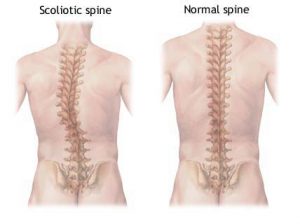 Scoliosis is a condition characterized by the abnormal curvature of the spine that causes a deviation to one side. It causes a physical deformity, making the spine look like the letter “C” or “S” instead of the letter “I”.
Scoliosis is a condition characterized by the abnormal curvature of the spine that causes a deviation to one side. It causes a physical deformity, making the spine look like the letter “C” or “S” instead of the letter “I”.
What are the Types of Scoliosis?
Scoliosis can be classified into five categories, depending on the age group affected:
- Congenital scoliosis: Spinal deformity is already present at birth. It occurs due to an abnormality in the formation of fetal ribs and spinal bones within the womb.
- Infantile scoliosis: Affects children below 3 years of age.
- Juvenile scoliosis: Seen in children in the age group of 4 to 10 years.
- Adolescent scoliosis: Affects teenagers and early teens (11 to 18 years)
- Adult scoliosis: Affects individuals above the age of 18 years
What are the causes of Scoliosis?
Scoliosis can be caused by a wide variety of conditions, depending on which it has been categorized into:
- Idiopathic scoliosis: This comprises the group of scoliosis in which the underlying cause has not been identified.
- Functional or nonstructural scoliosis: This refers to a category of scoliosis wherein the spine looks curved even in the absence of any structural defect. This may result from an underlying inflammatory condition or as a compensatory effect to balance the leg inequalities.
- Neuromuscular scoliosis: This form of scoliosis can occur due to neurological changes that affect the muscles, such as cerebral palsy, muscular dystrophy, spina bifida, and polio.
- Syndrome-associated scoliosis: This refers to scoliosis that develops as a part of a syndrome such as Marfan syndrome and Skeletal dysplasia. Marfan syndrome is an inherited connective tissue disorder affecting the ligaments of the spine. It increases the laxity of the ligaments, making them unable to hold the vertebrae firmly in place and thereby leading to scoliosis. Skeletal dysplasia is a growth disorder characterized by dwarfism due to abnormalities in the growth and development of bones and cartilage. This may also cause scoliosis.
- Degenerative scoliosis: This form of scoliosis is associated with degenerative changes in the spine due to the aging process, such as with osteoporosis, spondylosis or degenerative disc disease.
What are the Signs And Symptoms of Scoliosis?
In the initial stage, idiopathic scoliosis may be asymptomatic. Some of the common symptoms include spinal curvature, abnormal gait, uneven shoulders and hip, difference in leg lengths, more prominent rib or shoulder blade when you bend in the front and back. In severe cases, it may also cause breathlessness.
How is Scoliosis Diagnosed?
- The diagnosis of scoliosis involves the review of your family and medical history along with a physical and neurological examination.
- Physical examination involves palpation of the spine, Adam’s forward bending test and plumb line test.
- A neurologic examination involves the evaluation of any signs of neurological injury such as numbness, muscle weakness or abnormal reflexes. Radiological examination involves X-ray of the spine in different positions, such as standing and bending forward.
What are the treatment options for Scoliosis
Non-operative treatment for Scoliosis
The non-operative treatment approach of scoliosis includes:
- Observation: No treatment is required for a spinal curve below 20 degrees. However, you are advised regular follow up visits to carefully monitored for the progression of the curve.
- Bracing: A back brace may be recommended in children with a curve between 20-40 degrees to stop the progression of scoliosis and prevent surgery. Bracing is not effective for congenital or neuromuscular scoliosis.
Operative treatment for Scoliosis
Surgery is generally a good option for those who have tried more conservative measures and may be appropriate for children or adolescents with severe curvatures. An open or Minimally Invasive Scoliosis Surgery can be considered.
 Kyphosis refers to a condition that leads to abnormal rounding on your back. It can be present at birth or develop in patients of young age – adolescence or young adults.
Kyphosis refers to a condition that leads to abnormal rounding on your back. It can be present at birth or develop in patients of young age – adolescence or young adults.
What Causes Kyphosis?
It happens due to one of the following reasons:
- Maintaining poor posture while sitting, standing, or sleeping
- Poor developmental growth during fetal development
- Old age
- Abnormally shaped vertebrae
What are the Symptoms of Kyphosis?
The below-mentioned symptoms might vary from patient to patient depending on the severity of their case. However, the most common symptoms of Kyphosis are:
- An irreversible hunch in the back
- Back pain
- Weakness or numbness in the arms, legs, and neck
- Breathing problem
- Loss of bladder control
What are the treatment options for Kyphosis?
- The treatment depends on the cause of the condition and may include bracing, physical therapy, medications, and surgery.
- Bracing may be necessary to prevent the curve from worsening if the cause of kyphosis is Scheuermann’s disease.
- Physical therapy (exercise program) may be recommended to increase your range of motion, flexibility, and strength.
- Surgery may be recommended if kyphosis is debilitating and painful, and does not respond to conservative treatment methods.
Minimally Invasive Deformity Correction
With the development of advanced equipments and instrumentation it is possible to perform certain Complex Deformity through Minimally Invasive Techniques also.
The benefit of using Minimally Invasive Techniques is of smaller scar, lesser tissue destruction, more precise instrumentation, better correction and lesser complications.







